What is Business Agility?
Discover adaptive ways of working that deliver more value, respond to change, and increase customer satisfaction.

About
Say hello to a new way of working


Agile (adjective) —
- having a mindset or organizational approach defined by practicing the values and principles of the Agile Manifesto to sense and respond to market changes
- describing frameworks, such as Scrum, as well as methods, tools, and approaches that leverage customer feedback to deliver value in rapid, high-value increments
What is an agile organization?
An agile organization is a human-centric organization that embraces an agile culture, no matter the framework, may be called agile if, throughout its ranks and teams, an agile mindset and agile values drive the delivery of customer value. These organizations constantly adapt their ways of working based on employee feedback. They value responding to change over following a plan, delivering iterative and incremental value to the customer often.
In Uncertain Business Conditions, Only the Agile Survive
Many business and team leaders think agile is a plug-and-play project management system or some magical scaling software that will heal your most dysfunctional departments. Buying into that illusion of quick-fix agility may mean that you never actually reap the benefits of being in a sustainably agile organization.
Agile and Scrum aren’t just for your developers. From the recent rise in agile marketing and finance departments to agile Human Resources (or People Operations) teams, high-performing companies around the world are thriving through uncertain and volatile times by embracing organizational agility with long-term sustainability in mind.
The benefits of business agility

Faster releases

Customer delight

Employee growth & retention

Value-driven

Return on investment

Rapid innovation

Adaptable teams

Reduces risk
So, how do you become "agile"?
Though strong leaders may foster the right environment for sustainable agility, it’s not achieved through a top-down directive from the C-suite. You may start by sending your managers to a Certified ScrumMaster, Certified Agile Leader, or product owner course, if you desire successful, lasting change across your organization, you must transform your culture. Scrum Alliance certified coaches and trainers help you with that culture shift. It helps to have agile experts by your side to guide your teams and leaders through the agile mindset shifts, practices, values, principles, and tools that help your business thrive.

Business
There's a better way to do business


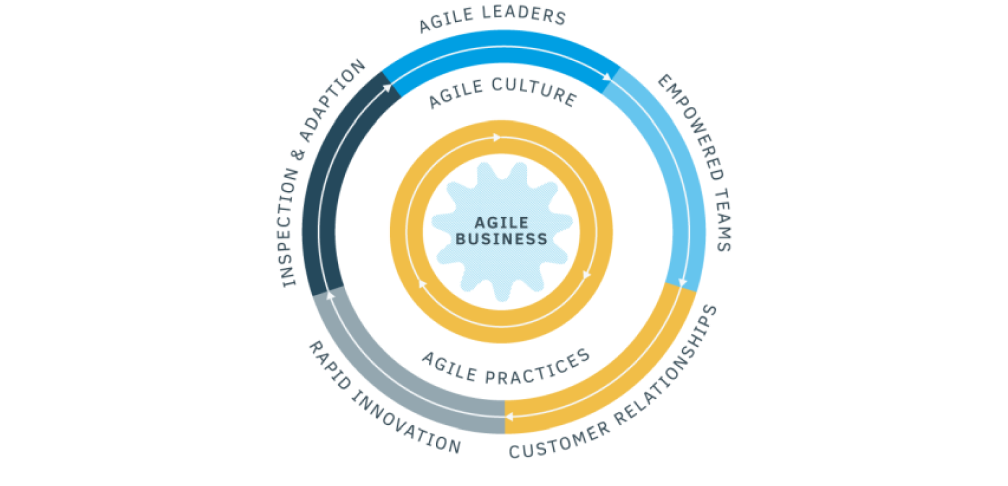
Sustainable Organizational Agility
What is business agility? Business agility is a company’s collective ability to adapt and respond rapidly to ever-changing market conditions. At Scrum Alliance, we believe successful business agility must be sustainable, which requires cultural innovation at all levels and in all departments of your organization.
Related: Creating the Agile Enterprise
Why do businesses use agility?
- Increases Your ROI
- Minimizes Risk to Encourage Innovation
- Improves Your Time to Market
- Ensures Your Product Iterations Deliver Customer Value
- Enhances Employee Morale and Retention
Key Predictive Indicators of Business Agility
In the 2019 Business Agility Report, we discovered three significant predictors of business agility based on a multi-year analysis of data. Organizations that report higher ratings in these three maturity measures also report higher overall business agility and associated Benefits.
Importantly, the 2020 Business Agility Report: Special Edition analysis reinforced that relentless improvement, funding models, and value streams remain the top three key predictors of business agility.
The top 3 predictors of business agility
Source: The Business Agility Report Responding to Disruption, 3rd Edition, 2020

ROI
Make smaller mistakes, faster


Is agile really that successful? What is the ROI in agile?
Looking for proof that agile delivers results beyond the team level? It can drive tremendous financial benefits for organizations. Oddly enough, these financial benefits are rarely given much attention in discussions about organizational agility, even though return on investment is a big part of any organization's decision to commit time, resources, and money to becoming agile.
Agile delivers performance against scope, quality, schedule, and budget. When you lower your execution cost, you improve your margin and reduce your investment payback period. That means you free up funds and internal resources for new investments.
Quality can deliver financial benefits in a number of ways: Better quality leads to more sales, allows for increased pricing, reduces support costs, and minimizes negative publicity/customer perception. Quality also drives customer satisfaction, which benefits your organization through repeat business, excellent references, and client advocacy.
Best Buy Canada Makes the Case for Business Agility
Beginning in 2016, Best Buy Canada radically shifted its approach to delivering value in eCommerce to Technology. Through the use of an iterative agile methodology instead of a linear “waterfall” process, and by shifting its focus from projects to products, the company significantly improved its ability to release new code to production and gained speed and efficiencies throughout its eCommerce sector. Capitalizing on this capability, company leaders estimate a $40M reduction per year in cost of value delivery in addition to the improved time to market, increased incremental revenue, and more robust revenue protection.
The company pushed decision making to cross-functional teams focused on specific product areas and developed the capacity to rapidly iterate, breaking a pattern of producing two or three major releases and a handful of minor ones each year. In the first six months of 2019 alone, the teams released 85 net new features on eCommerce and technology at large within the organization.

Risk
Risky business? Nah.


How Rapid Iteration & Customer Representation Help You Avoid Risk
Less obvious, yet tremendously important, is the fact that agility also drives risk avoidance. When a company decides to invest in anything, there's at least some element of risk. Products and projects carry a lot of uncertainties that contribute to those risks, such as:
- Errors in the business case
- Management and contingency reserves
- Cost of correcting and managing triggered risks
Agile tries to pull risk upstream and address it earlier by focusing your team’s efforts on the minimum viable iteration required to deliver customer satisfaction. With agility, you reduce your need for reserves and spend less money on risk management and recovery. Better risk control will also reduce exposure in areas as diverse as regulatory compliance, public perception, and the ability to hire and retain top talent.
Sustainable Business Agility in Practice
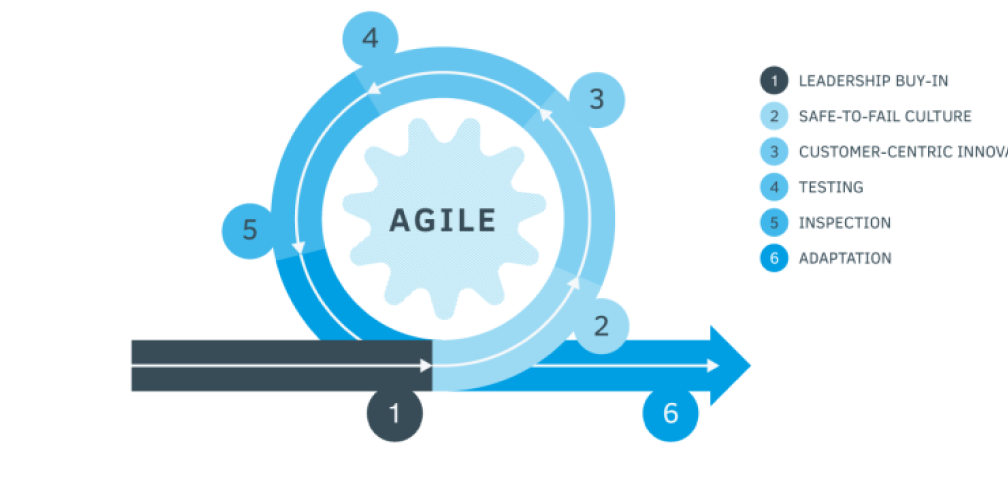
At a macro level, agility’s short solution-development cycles act as early warning systems for a project that's misaligned with market or customer needs. This allows you to identify projects likely to fail and terminate them earlier in the development cycle. By doing so, you reduce project portfolio costs and lower the risk of developing a product that will fail in the marketplace.
Agility delivers risk reduction in a number of other ways as well. The ability to have customer representation in your product or service development eliminates much of the uncertainty associated with launching a solution. It also allows potential issues to be identified earlier in the development cycle, improving the visibility of risks. That makes corrective actions quicker and cheaper and reduces the impact of those issues.


Innovation
Go ahead, get creative


A Culture of Radical Innovation Improves Your Time to Market
Radically innovative companies regularly examine external factors affecting the business because their agility poises them to react effectively and efficiently, and they know this is how they stay ahead of market competitors. Volatility, uncertainty, complexity, and ambiguity (VUCA) in your market make it important for your teams to deliver product or service iterations rapidly to stay ahead of the competition and changing conditions.
Alert and opportunity-seeking employees who are in tune with your customer base drive a culture of innovation, which translates to teams and businesses that thrive under those VUCA conditions. As market demands fluctuate, agile teams quickly examine new conditions and adapt because their leadership encourages constant experimentation within the organization. In doing so, they position your business to be the first to see how the market responds to changes and can innovate rapidly to deliver better results more quickly.

First, Practice Transparency & Build Trust
There is a close relationship between innovation and openness. Learning keeps minds open to receiving feedback and new information. As a leader, it is important to let go of fear to trust, listen, be patient, and know that investing in your employees and their development is key to retaining and maintaining sustainability. Create space and time for employees to experience learning opportunities in which they are encouraged to fail fast and often, grow professionally, and utilize new skills.
The entire company must become a learning organization, not just in classrooms, but with real-life customers and consequences. Employees need to be encouraged to experiment with new products, procedures, and services in order to become more efficient and productive in their work. It is important that everyone in the business helps to create, shape, and transform your culture to experiment, iterate, and share their findings.
COVID-19 Helped Agile Businesses Mature in 2020
COVID-19’s global impact on organizations is undeniable. We compared survey data prior to and during the onset of the COVID-19 lockdown to gain unique insights into the disruption caused and adaptations applied.
The key finding is a significant increase in average maturity post-COVID-19. Increases are thematically concentrated in the areas of customer focus as well as the operation of an organization’s support functions such as Human Resources and Finance.
Measuring Businesses Pre- & Post-COVID for Agile Maturity
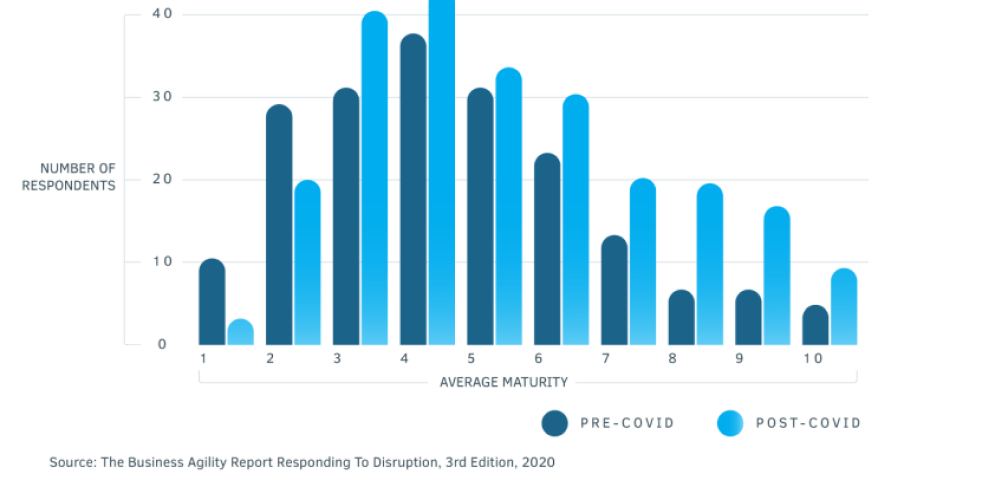

Teams
Don't avoid change. Use it


How Self-Organizing Teams Help You Manage Change
Agile organizations employ the power of self-organizing teams at every turn. The cultural shift into sustainable agility is a move from hierarchy and information hoarding to self organization and knowledge sharing. Decisions in an agile organization are not made by one individual, but rather pushed to those who work in closest relationship to the customers.
In agile organizations, employees and leaders are transparent about the work they do and the value they bring. They are no longer trying to protect information, but rather democratize it. With open communication pathways, your teams’ interactions become more about efficiency, discovery, and innovation than perfection, as everyone knows there will be an opportunity to evaluate, iterate, and refine. Communication is made frictionless as daily stand-ups and weekly all-hands meetings are conducted, so that each person within the organization is aware of what is happening in each team, department, or location.
Hierarchical Teams vs Self-Organizing Teams
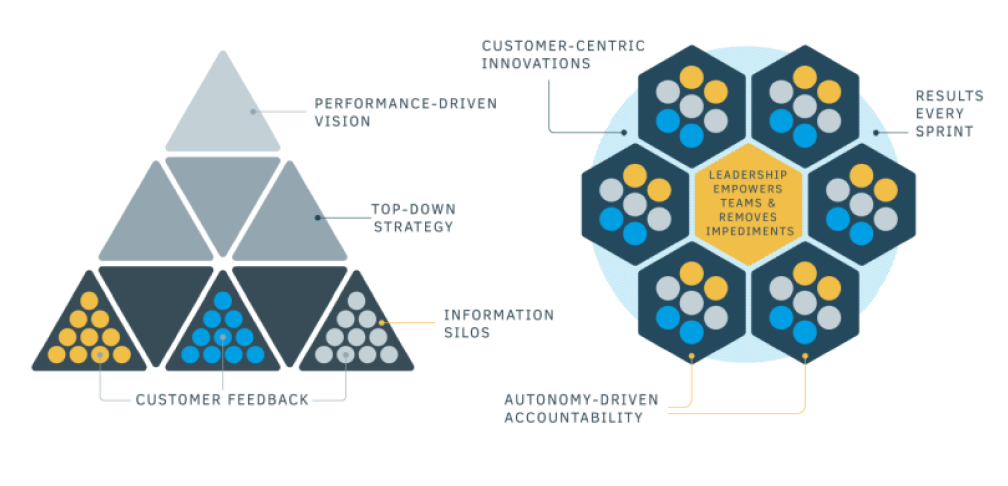
Change Is a Good Thing
Effective change management is directly associated with the vision of your company, and it is evolution-oriented. Change management has three parts: testing change, implementing change and perceiving change. Business is ever-evolving. Innovative business partnerships are now more crucial than before. Technology is also encouraging competition. Startups and agile high-tech firms are setting the pace that companies that do not follow go-to-market trends could soon be left out of the race. Demographics and global economics are shifting. The world is changing rapidly. On the same nerve, emerging markets are growing exponentially, which means agile firms have the power to respond immediately.
Co-Creating an Agile Culture
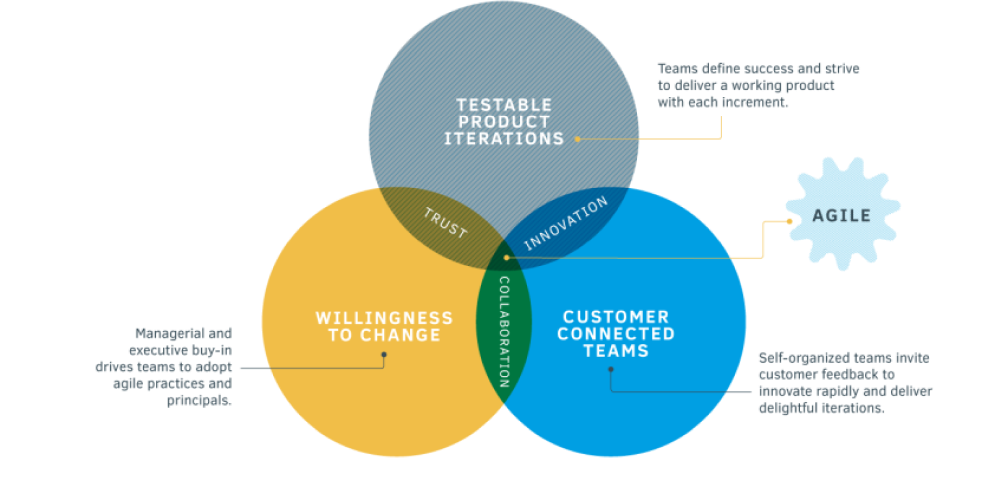
Engagement Leads to Satisfaction
Never underestimate the power of the positive influence of always getting things done — agilists swear by it. That’s how agility also lowers internal risks: When your employees are members of self-managed teams, they feel more engaged in their work and share collective responsibility for delivering high-quality results rapidly, which leads to a greater sense of job satisfaction, better deliverables, and a lower turnover rate. When you make the people you have happier, it improves customer satisfaction, period. The secret to success for any business is customer loyalty, which translates to how your business handles customer service, as well as selling topnotch products and services. When your company is agile and responds to customer needs, you improve your customer loyalty.
Highly engaged employees produce better-quality work more quickly, minimizing the likelihood of expensive mistakes that take a long time to discover. Change is a constant factor in the market — the last thing you need is a six-month mistake. Employees handle change best when their morale levels are high. Their morale, therefore, has a direct effect on your company's ability to increase quality deliverables. An agile organization that considers employee views and input can achieve greatness.


Barriers
Overcome hurdles. Don't become one.

Barriers to Business Agility:
Untrained Executive Leadership
Lack of support and financial aid from the senior managers of the company makes it hard for any transformation to occur. The problem is that one section will embrace agile approaches, but soon everything will fizzle out since there is no broad support from the company.
Lack of Enterprise View
This includes numerous considerations. For instance, the lack of a centralized program that promotes agility in an organization. As a result, the implementation of agile becomes problematic because it is less effective if it is only implemented in a limited number of departments or teams.

Difficulty Responding to Organizational Change
For agile to work, it needs an organizational change in all areas of the business and not just in product development. For example, layers of management must be reduced. Companies should put more effort into employee training, talent management, performance management processes, as well as business technology partnerships. The focus must be on removing barriers to decision-making and delivering value quickly to reduce turnaround time on customer feedback.
Related: 3 Ways HR Leaders Can Encourage a Culture of Innovation

Not Factoring in Transition Time
Time is everything when it comes to change. Businesses must establish realistic goals right from the start. Instead of pursuing an all-at-once approach, companies must adapt change in waves, gently breaking down conventional barriers and resistance to change.
It is not easy to create enterprise agility and will not happen in one day, but it is an area that can make a great impact with the support of professionals who are trained in improvement processes and can guide you and your team throughout the journey.
Related: Agile Transformations Start at the Top
Top 10 Themes for Addressing Challenges Along the Agile Journey


Agile Manifesto
Start with shared values

4 Values of the Agile Manifesto
![]()
The Key Values and Principles of Agile
Nearly 20 years ago, 17 software developers came together in Snowbird, Utah to propose a new way of developing software “by doing it and helping others do it.” Through this work, the signers of the Agile Manifesto understood how much of an impact these principles would help them in the field of software development—but they had no idea how quickly their ideas would spread beyond their industry. Values the Manifesto creators cited as paramount were:
- Individuals and interactions over processes and tools
- Working software over comprehensive documentation
- Customer collaboration over contract negotiation
- Responding to change over following a plan
![]()
12 Agile Principles

Training
Join our global agile community

Learn from the Leaders in Business Agility & Agile Leadership
Scrum Alliance was founded and funded by the agile community to serve the agile community. We’re a member-driven 501c6 trade association with over a million internationally recognized certifications. We take the privilege of serving agilists seriously as we continue to nurture the agile movement by providing education, advocacy, research, and connection to the largest community of Scrum and agile professionals.
Since Scrum Alliance first introduced the training course and certification of a Certified ScrumMaster in 2001, the growing needs of agilists around the world continue to drive our organization and certifications. Over the years, our community evolved to lead in the broader agile space, and we joined them in embracing agile leadership as pivotal in our mission to transform the world of work.
![]()
In order to truly help organizations undergo agile transformations, leadership must be on board with an agile mindset shift. From how our organization is structured to how we handle the unexpected, we strive to uphold the principles of business agility and set an example for our community to follow. We take pride in our agility as an organization, and we use the Agile Manifesto to guide our strategy and decisions.
As agile leaders, we value:
"Individuals and interactions over processes and tools.
Working software over comprehensive documentation. Customer collaboration over contract negotiation.
Responding to change over following a plan."
We inspire, educate, and collaborate with leaders and organizations to help them thrive in an era of change and disruption. Education and coaching to guide and support these leaders in their journey to steep innovation, improved quality and market leadership.
Businesses want to accelerate innovation, improve quality and results and be market leaders. They need adaptability to respond rapidly to constant external market change. To do that, they need to build an adaptive company culture, for it to be successful there needs to be a meaningful lasting change (not quick and easy) and it needs to happen across the organization at all levels and departments. To do that, they need to change their mindset AND be educated and guided.
Related: Can Agile Principles Save the World?

Coaching
It's easier with a Certified Agile Coach

Agile Coaching
Certified agile coaching and training
Many companies erroneously believe agile practices are something only IT teams implement. However that couldn’t be further from the truth. Organizations, from the leadership to entry-level employee, can use agility to be competitive, leverage new opportunities and increase customer satisfaction. Sustainable organizational agility requires a whole company shift in culture; it doesn’t happen overnight and it’s not always easy. But it’s worth it.
Related: 4 Ways to Ease the Transition from Waterfall to Agile
Why?
With something as nuanced and complex as an agile transformation, organizations cannot go it alone. To find your way in the agile space and through your agile journey, you need someone who knows the proven paths as well as how to look for and overcome common obstacles and challenges. The best way to achieve lasting success in your agile transformation is to bring in a guide — specifically a Certified Agile Coach — to help.
Related: 3 Steps for Building an Agile-Friendly C-Suite
The problem for many companies is how to find the quality coaches and consultants. When everyone can call themselves an agile coach or show you a set of initials they’ve obtained, how can leaders distinguish what’s good advice from what’s not?
Scrum Alliance has done the leg work for businesses. We set the gold standard for agile coaching in the world. We carefully evaluate all the Certified Agile Coach candidates and only certify the best, either as a Certified Enterprise Coach (capable of helping with organizational change) or Certified Team Coach (specialists in helping with team-level challenges), or both. Agility requires a mindset shift that needs to be adopted long term.
The cost of quickly iterating is cheaper than ever. Now is the time to be bold and embrace change through an agile mindset.

Implementation
Lead cultural innovation

How to Boost Organizational Agility in Your Company
Embrace a Culture of Change
To identify, understand and influence the culture within an organization, analyze how change might be approached differently based on existing organizational culture, and the influence that culture has on speed, risk, and receptiveness to change. By embracing empirical strategy and the importance of transparency and feedback loops for continual revision, you are better able to assist an organization and its leaders through a change process.
Related: Creating the Agile Enterprise
![]()
Rethink “Value”
Each person on your team offers a different interpretation of the term “value” and, therefore, how agility will positively impact value creation. It is important to understand how culture and the way value is interpreted are related, and how that relationship will affect organizational outcomes.
Related: 7 Skills You Need to Be a Great Product Owner
Support Self-Governance with Self-Organizing Teams
With agile, you use a product owner to prioritize and distill your vision to each team. From there, your teams decide how the work is done. This fuels a culture of innovation and creativity. To do this effectively, you must understand the relationship between organizational culture and design and how agile approaches aid the organizational change process as well as the relationship between culture and leadership mindset and behaviors. You will likely need to adjust your governance policies as you come to understand agility and its influence on culture and creating value.
Related: Rethinking Management the Agile Way
![]()
Establish Universal Leadership Teams
One way to make sure that your leadership team has broad perspectives is to look for leadership beyond the traditional hierarchy. Discuss priorities, problems, and solutions with employees at all levels of the company, especially those who work directly with your customers. Also consider setting up advisory teams with agilists, leaders, customers and would-be customers outside of your organization to prevent the echo chamber effect.
Related: The Anatomy of an Excellent Scrum Team
![]()
Data Analytics Is Key
When applying agile approaches across an organizational system, view challenges to creating value through the lens of organizational metrics for alignment with agile values and how they impact behavior and results. Analytics strategy is closely associated with a company's objectives. So, decide who can access the business data and make adjustments to serve the company better. Use analytics where they can yield great results.
![]()
Prepare Your Departments to Respond Quickly
How do different departments in your company relate to each other and external parties, and how do you manage such relationships? Determine how and where you want your elements of the value chain to be shared. Is it via collaboration or partnership to foster growth? Determine how sharing data with others may affect the industry landscape. Keep in mind changes in technology are breaking barriers between businesses and it will impact your business considerably.
Business benefits of agile are clear: superior product quality, a great partnership between the business and IT, as well as increased customer satisfaction are some of the business benefits of agile that could arise when your business adapts the agile approach. What are you waiting for? You can start by getting a professional course from Scrum Alliance and learn more about agility and how it could help your company thrive.

Leadership
Become a truly agile leader

![]()
Attributes of Agile Leaders
Commitment & Respect
Overloading teams and team members is a common mistake agile leaders make as they learn to educate themselves and the organization about how agile teams operate most effectively. Commit to the health of your team by respecting their bandwidth and commitments. Agility requires your team to focus its energy on delivering a limited number of minimally viable deliverables at a time. As a leader, you may need to push back on the business and other leaders — your teams succeed by prioritizing projects and outcomes. Focus on removing barriers and setting boundaries.
![]()
Openness
Influential agile leaders give regular feedback that's positive, neutral, and "negative." They also encourage, request, and enthusiastically receive feedback from their employees and teams. There are many formats through which this can be done, both formal and informal, and it's a great idea to have the formal ones in place to ensure nothing falls through the informal feedback cracks. Remember, as an agile leader, your job includes mentorship and coaching, not just "management." If you implement these systems within your teams and organization — your internal customers — you'll be better at encouraging that feedback from the external audiences as well.
Related: Adapt Your Leadership Style for Rapid Change and Uncertainty
![]()
Empowerment
Empowerment indicates the relationship between employees and leadership via autonomy and authority. It is characterized by the even distribution of power. Power is crucial and leaders that give authority to their subordinates respond accurately and efficiently to their environment. They invest their time and effort in their company and possess high levels of morale. For instance, if you are an empowered employee, you will be more flexible than a downtrodden employee.
![]()
Tolerance
This is a company's desire to achieve a culture that goes beyond the face of ambiguity. The market is extremely unpredictable. So, you need to prepare to spot changes and respond immediately and efficiently. It is also important to be flexible because different situations require different reactions.
![]()
Vision
What is the main goal of your organization? Do you have a purpose? The vision of your company is as important thing ever. It is what unifies all the departments of your company. It is the inspiration behind all the operations in your company and steers you in the right direction.
Related: Critical Behaviors for Agile Leaders